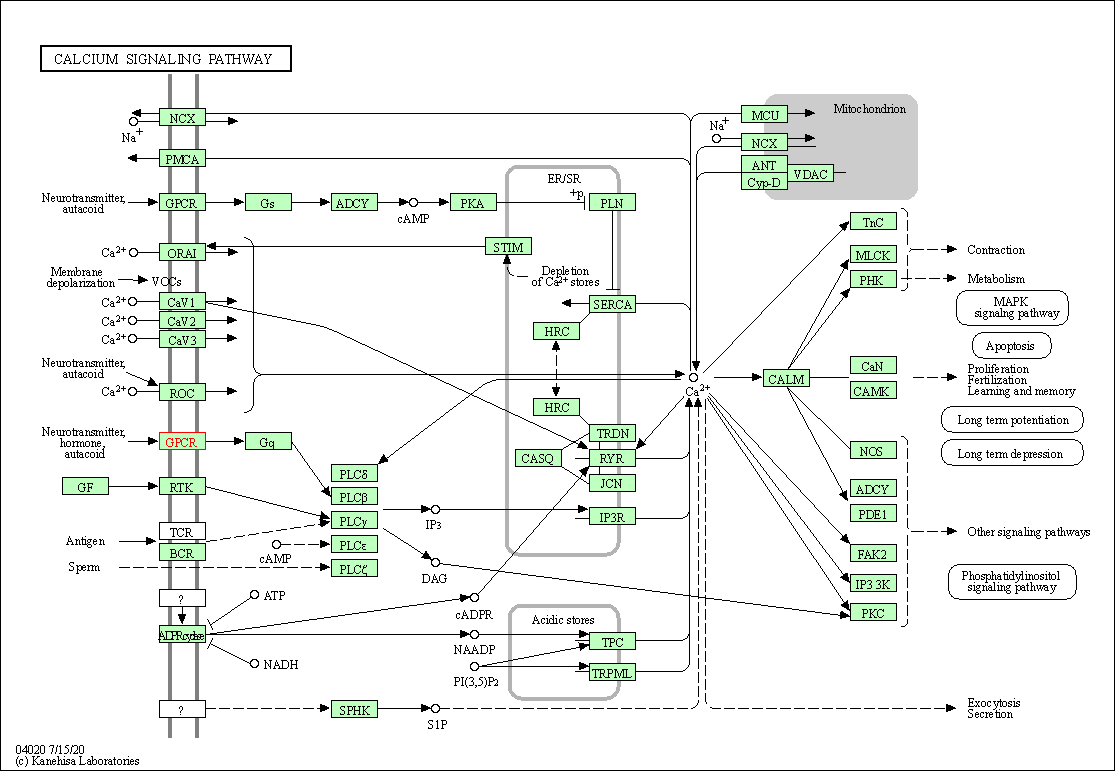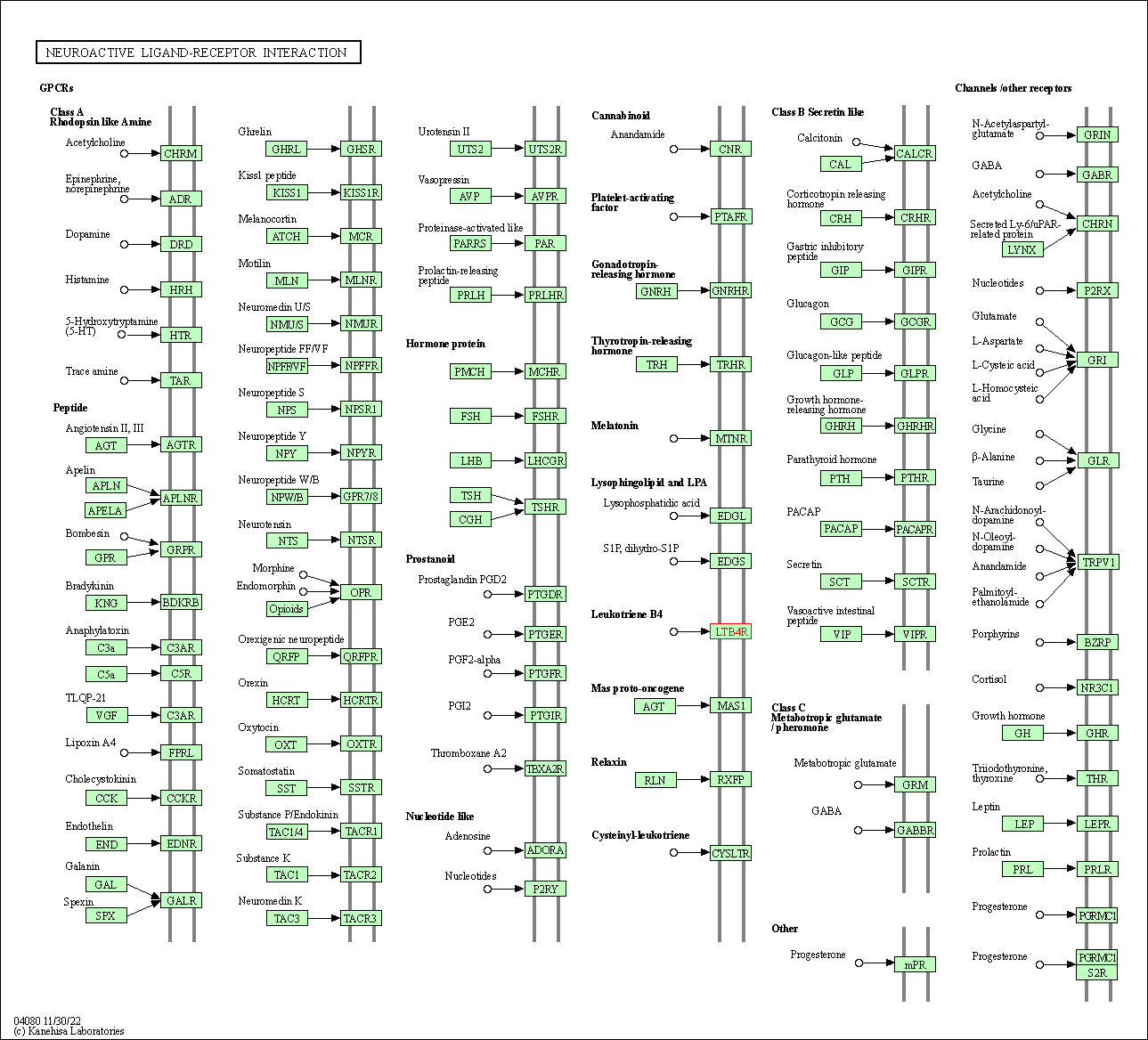Target Information
| Target General Information | Top | |||||
|---|---|---|---|---|---|---|
| Target ID |
T30563
(Former ID: TTDR00545)
|
|||||
| Target Name |
Leukotriene B4 receptor 2 (LTB4R2)
|
|||||
| Synonyms |
Seven transmembrane receptor BLTR2; Leukotriene B4 receptor BLT2; Leukotriene B(4) receptor BLT2; LTB4-R2; LTB4-R 2; LTB4 receptor JULF2; BLTR2; BLT2R
Click to Show/Hide
|
|||||
| Gene Name |
LTB4R2
|
|||||
| Target Type |
Clinical trial target
|
[1] | ||||
| Disease | [+] 2 Target-related Diseases | + | ||||
| 1 | Human immunodeficiency virus disease [ICD-11: 1C60-1C62] | |||||
| 2 | Renal cell carcinoma [ICD-11: 2C90] | |||||
| Function |
Mediates chemotaxis of granulocytes and macrophages. The response is mediated via G-proteins that activate a phosphatidylinositol-calcium second messenger system. The rank order of affinities for the leukotrienes is LTB4 > 12-epi-LTB4 > LTB5 > LTB3. Low-affinity receptor for leukotrienes including leukotriene B4.
Click to Show/Hide
|
|||||
| BioChemical Class |
GPCR rhodopsin
|
|||||
| UniProt ID | ||||||
| Sequence |
MSVCYRPPGNETLLSWKTSRATGTAFLLLAALLGLPGNGFVVWSLAGWRPARGRPLAATL
VLHLALADGAVLLLTPLFVAFLTRQAWPLGQAGCKAVYYVCALSMYASVLLTGLLSLQRC LAVTRPFLAPRLRSPALARRLLLAVWLAALLLAVPAAVYRHLWRDRVCQLCHPSPVHAAA HLSLETLTAFVLPFGLMLGCYSVTLARLRGARWGSGRHGARVGRLVSAIVLAFGLLWAPY HAVNLLQAVAALAPPEGALAKLGGAGQAARAGTTALAFFSSSVNPVLYVFTAGDLLPRAG PRFLTRLFEGSGEARGGGRSREGTMELRTTPQLKVVGQGRGNGDPGGGMEKDGPEWDL Click to Show/Hide
|
|||||
| 3D Structure | Click to Show 3D Structure of This Target | AlphaFold | ||||
| Drugs and Modes of Action | Top | |||||
|---|---|---|---|---|---|---|
| Clinical Trial Drug(s) | [+] 2 Clinical Trial Drugs | + | ||||
| 1 | LTB4 | Drug Info | Phase 2 | Human immunodeficiency virus infection | [2] | |
| 2 | Biomed 101 | Drug Info | Phase 1 | Kidney cancer | [3] | |
| Discontinued Drug(s) | [+] 1 Discontinued Drugs | + | ||||
| 1 | CP-105696 | Drug Info | Discontinued in Phase 1 | Inflammatory bowel disease | [6], [7] | |
| Mode of Action | [+] 4 Modes of Action | + | ||||
| Inhibitor | [+] 6 Inhibitor drugs | + | ||||
| 1 | LTB4 | Drug Info | [1] | |||
| 2 | Biomed 101 | Drug Info | [1] | |||
| 3 | CP-105696 | Drug Info | [10] | |||
| 4 | LY-292728 | Drug Info | [11] | |||
| 5 | (3S,4R)-3-Benzyl-7-isopropyl-chroman-4-ol | Drug Info | [10] | |||
| 6 | LY-282210 | Drug Info | [11] | |||
| Agonist | [+] 4 Agonist drugs | + | ||||
| 1 | 12-epi LTB4 | Drug Info | [12] | |||
| 2 | 12-hydroxyheptadecatrienoic acid | Drug Info | [13] | |||
| 3 | 20-hydroxy-LTB4 | Drug Info | [14] | |||
| 4 | CAY10583 | Drug Info | [16] | |||
| Antagonist | [+] 2 Antagonist drugs | + | ||||
| 1 | BIIL 260 | Drug Info | [15] | |||
| 2 | ZK-158252 | Drug Info | [12] | |||
| Modulator | [+] 1 Modulator drugs | + | ||||
| 1 | [3H]LTB4 | Drug Info | [17] | |||
| Cell-based Target Expression Variations | Top | |||||
|---|---|---|---|---|---|---|
| Cell-based Target Expression Variations | ||||||
| Different Human System Profiles of Target | Top |
|---|---|
|
Human Similarity Proteins
of target is determined by comparing the sequence similarity of all human proteins with the target based on BLAST. The similarity proteins for a target are defined as the proteins with E-value < 0.005 and outside the protein families of the target.
A target that has fewer human similarity proteins outside its family is commonly regarded to possess a greater capacity to avoid undesired interactions and thus increase the possibility of finding successful drugs
(Brief Bioinform, 21: 649-662, 2020).
Human Pathway Affiliation
of target is determined by the life-essential pathways provided on KEGG database. The target-affiliated pathways were defined based on the following two criteria (a) the pathways of the studied target should be life-essential for both healthy individuals and patients, and (b) the studied target should occupy an upstream position in the pathways and therefore had the ability to regulate biological function.
Targets involved in a fewer pathways have greater likelihood to be successfully developed, while those associated with more human pathways increase the chance of undesirable interferences with other human processes
(Pharmacol Rev, 58: 259-279, 2006).
Human Similarity Proteins
Human Pathway Affiliation
|
|
| KEGG Pathway | Pathway ID | Affiliated Target | Pathway Map |
|---|---|---|---|
| Calcium signaling pathway | hsa04020 | Affiliated Target |

|
| Class: Environmental Information Processing => Signal transduction | Pathway Hierarchy | ||
| Neuroactive ligand-receptor interaction | hsa04080 | Affiliated Target |

|
| Class: Environmental Information Processing => Signaling molecules and interaction | Pathway Hierarchy | ||
| Chemical Structure based Activity Landscape of Target | Top |
|---|---|
| Drug Property Profile of Target | Top | |
|---|---|---|
| (1) Molecular Weight (mw) based Drug Clustering | (2) Octanol/Water Partition Coefficient (xlogp) based Drug Clustering | |
|
|
||
| (3) Hydrogen Bond Donor Count (hbonddonor) based Drug Clustering | (4) Hydrogen Bond Acceptor Count (hbondacc) based Drug Clustering | |
|
|
||
| (5) Rotatable Bond Count (rotbonds) based Drug Clustering | (6) Topological Polar Surface Area (polararea) based Drug Clustering | |
|
|
||
| "RO5" indicates the cutoff set by lipinski's rule of five; "D123AB" colored in GREEN denotes the no violation of any cutoff in lipinski's rule of five; "D123AB" colored in PURPLE refers to the violation of only one cutoff in lipinski's rule of five; "D123AB" colored in BLACK represents the violation of more than one cutoffs in lipinski's rule of five | ||
| Co-Targets | Top | |||||
|---|---|---|---|---|---|---|
| Co-Targets | ||||||
| Target Profiles in Patients | Top | |||||
|---|---|---|---|---|---|---|
| Target Expression Profile (TEP) | ||||||
| Target Affiliated Biological Pathways | Top | |||||
|---|---|---|---|---|---|---|
| KEGG Pathway | [+] 2 KEGG Pathways | + | ||||
| 1 | Calcium signaling pathway | |||||
| 2 | Neuroactive ligand-receptor interaction | |||||
| Panther Pathway | [+] 1 Panther Pathways | + | ||||
| 1 | Inflammation mediated by chemokine and cytokine signaling pathway | |||||
| Reactome | [+] 2 Reactome Pathways | + | ||||
| 1 | Leukotriene receptors | |||||
| 2 | G alpha (q) signalling events | |||||
| WikiPathways | [+] 4 WikiPathways | + | ||||
| 1 | Gastrin-CREB signalling pathway via PKC and MAPK | |||||
| 2 | GPCR ligand binding | |||||
| 3 | GPCR downstream signaling | |||||
| 4 | GPCRs, Other | |||||
| Target-Related Models and Studies | Top | |||||
|---|---|---|---|---|---|---|
| Target Validation | ||||||
| Target QSAR Model | ||||||
| References | Top | |||||
|---|---|---|---|---|---|---|
| REF 1 | Diaryl ether/carboxylic acid derivatives of LY255283: Receptor antagonists of leukotriene B4, Bioorg. Med. Chem. Lett. 3(10):1985-1990 (1993). | |||||
| REF 2 | ClinicalTrials.gov (NCT00251537) A Pilot Study of LTB4 in HIV-1 Infected Adults in LTB4 Sweden AB. | |||||
| REF 3 | ClinicalTrials.gov (NCT00004890)Biomed 101 and Interleukin-2 in Treating Patients With Kidney Cancer in National Cancer Institute (NCI). | |||||
| REF 4 | URL: http://www.guidetopharmacology.org Nucleic Acids Res. 2015 Oct 12. pii: gkv1037. The IUPHAR/BPS Guide to PHARMACOLOGY in 2016: towards curated quantitative interactions between 1300 protein targets and 6000 ligands. (Ligand id: 6157). | |||||
| REF 5 | Trusted, scientifically sound profiles of drug programs, clinical trials, safety reports, and company deals, written by scientists. Springer. 2015. Adis Insight (drug id 800003085) | |||||
| REF 6 | URL: http://www.guidetopharmacology.org Nucleic Acids Res. 2015 Oct 12. pii: gkv1037. The IUPHAR/BPS Guide to PHARMACOLOGY in 2016: towards curated quantitative interactions between 1300 protein targets and 6000 ligands. (Ligand id: 3368). | |||||
| REF 7 | Trusted, scientifically sound profiles of drug programs, clinical trials, safety reports, and company deals, written by scientists. Springer. 2015. Adis Insight (drug id 800005644) | |||||
| REF 8 | URL: http://www.guidetopharmacology.org Nucleic Acids Res. 2015 Oct 12. pii: gkv1037. The IUPHAR/BPS Guide to PHARMACOLOGY in 2016: towards curated quantitative interactions between 1300 protein targets and 6000 ligands. (Ligand id: 3351). | |||||
| REF 9 | Trusted, scientifically sound profiles of drug programs, clinical trials, safety reports, and company deals, written by scientists. Springer. 2015. Adis Insight (drug id 800001833) | |||||
| REF 10 | 3-Substituted-4-hydroxy-7-chromanylacetic acid derivatives as antagonists of the leukotriene B4 (LTB4) receptor, Bioorg. Med. Chem. Lett. 7(17):2307-2312 (1997). | |||||
| REF 11 | Biphenylyl-substituted xanthones: highly potent leukotriene B4 receptor antagonists. J Med Chem. 1993 Nov 26;36(24):3982-4. | |||||
| REF 12 | Hydroxyeicosanoids bind to and activate the low affinity leukotriene B4 receptor, BLT2. J Biol Chem. 2001 Apr 13;276(15):12454-9. | |||||
| REF 13 | 12(S)-Hydroxyheptadeca-5Z, 8E, 10E-trienoic acid is a natural ligand for leukotriene B4 receptor 2. J Exp Med. 2008 Apr 14;205(4):759-66. | |||||
| REF 14 | A G-protein-coupled receptor for leukotriene B4 that mediates chemotaxis. Nature. 1997 Jun 5;387(6633):620-4. | |||||
| REF 15 | Clinical trial of a leucotriene B4 receptor antagonist, BIIL 284, in patients with rheumatoid arthritis. Ann Rheum Dis. 2007 May;66(5):628-32. | |||||
| REF 16 | Characterization of a mouse second leukotriene B4 receptor, mBLT2: BLT2-dependent ERK activation and cell migration of primary mouse keratinocytes. J Biol Chem. 2005 Jul 1;280(26):24816-23. | |||||
| REF 17 | URL: http://www.guidetopharmacology.org Nucleic Acids Res. 2015 Oct 12. pii: gkv1037. The IUPHAR/BPS Guide to PHARMACOLOGY in 2016: towards curated quantitative interactions between 1300 protein targets and 6000 ligands. (Target id: 268). | |||||
If You Find Any Error in Data or Bug in Web Service, Please Kindly Report It to Dr. Zhou and Dr. Zhang.

